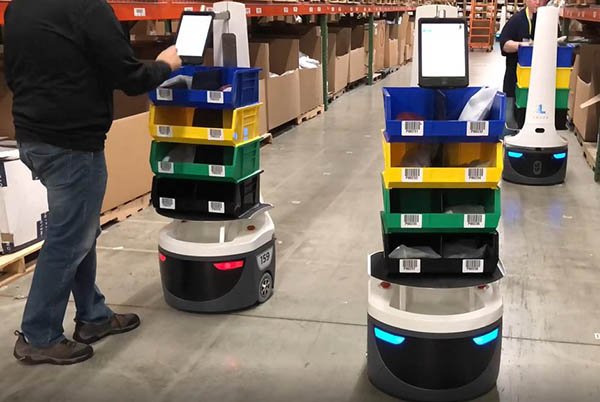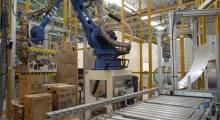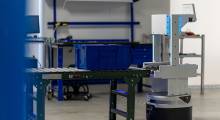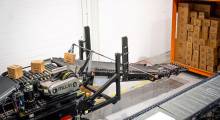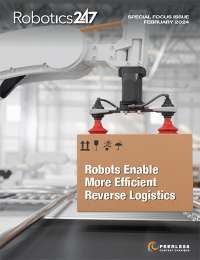Warehouses today have become centers of technological innovation. Technologies like Internet of Things networks and automation have become standard, as facilities strive for higher productivity and resiliency. Robotic picking systems have garnered particular attention recently, and for good reason.
Warehouse robots as a whole are becoming increasingly common, with 50,000 facilities using them by 2025, predicts ABI Research. Pick-and-place robots have seen more interest than most, but the reasons why may not be immediately clear. Here’s how robots can improve picking operations in warehouses.
Improved efficiency
The most immediately recognizable benefit of robots in picking is that they can improve productivity. Repetitive tasks are ideal for automation because machines can typically perform them faster than people, who may find the job tedious. After hours of doing a monotonous task, human workers can start to grow tired and slow down, but not robots.
Pick-and-place robots further improve efficiency by helping their human counterparts. Implementing robots can ease the workload on staffers, freeing them to focus on other, value-adding tasks. These machines work alongside people instead of replacing them, enabling them to work more efficiently due to less stress. This leads to higher overall productivity.
Modeling software can also help you discover the best uses for your pick-and-place robots. For example, Maplesoft was able to help a company solve a motor failure problem in its pick-and-place robots, improving its manufacturing process and saving the cost of frequent replacements.
“The company was able to essentially apply a software update to what was previously expected to be costly, on-site hardware replacements for larger motors,” Maplesoft recalled in a case study. “Going forward, they are using their MapleSim models for other robots, minimizing the high costs of over-engineered components and unexpected on-site repairs.”
Higher accuracy
In addition to working faster than humans, robotic picking systems are typically more accurate. These machines improve accuracy by reducing human interactions, which can lead to errors.
Technologies like pick-to-light and pick-to-HUD systems can reduce errors by 67% compared to traditional, entirely manual processes. Picking robots operate exclusively off these resources and lack the capacity to lose focus on them. As such, they can offer far higher accuracy, leading to smoother, more efficient operations.
People can easily grow tired or bored with repetitive work, losing their focus and making mistakes, but robots don’t have this problem.
“We’re going to become caretakers for the robots,” predicted futurist Gray Scott. “That’s what the next generation of work is going to be.”
More employers will start looking for robotics programmers to make sure their in-house robots perform the proper tasks and receive regular maintenance.
Scalability and flexibility
Warehouse robotics can improve picking operations by making them more easily scalable. Robots give warehouses the ability to artificially expand their workforce during peak seasons. For example, when online orders pick up around the holidays, facilities could add more robots into their operations, helping workers handle the increased workload.
“Forward-thinking 3PLs [third-party logistics providers] and retailers are making moves now to digitize their operations and prepare for possibly their best peak season yet,” said Currin McCarty, enterprise sales executive for the 3PL segment at Locus Robotics.
Industry professionals are expecting consumer demand to be higher than last year.
Traditionally, warehouses have adapted to seasonal demand by hiring temporary workers, but that’s becoming increasingly challenging. Job openings in the sector are nearing a 20-year high, as many facilities struggle to find enough employees to keep up with demand. Automation lets them do so without seasonal workers, as well as avoid costs and lost time from onboarding.
If you’re interested in setting up robotics solutions, “3PLs and retailers looking to go-live before peak should have agreements signed by early September,” recommended McCarty.
Warehouse robots are increasingly crucial
In today’s increasingly competitive landscape, warehouses must do everything they can to optimize their operations. In the face of growing labor shortages and rising demand, automation is the solution in many areas. Pick-and-place robots, in particular, are becoming less of an advantage and more of a necessity.
Picking is ideal for automation, thanks to its repetitive nature and historical inefficiency. Robots can help warehouses move past long-standing obstacles and meet the needs of the growing e-commerce sector. Before long, robotic picking systems will be an industry standard.

About the author
Emily Newton is a tech writer who enjoys writing about the latest innovations changing our world. Read more of her articles online at Revolutionized Magazine.
Article topics
Email Sign Up

